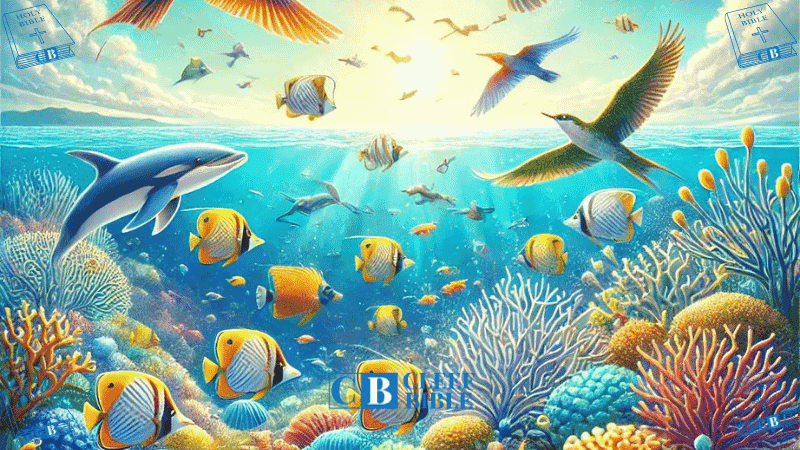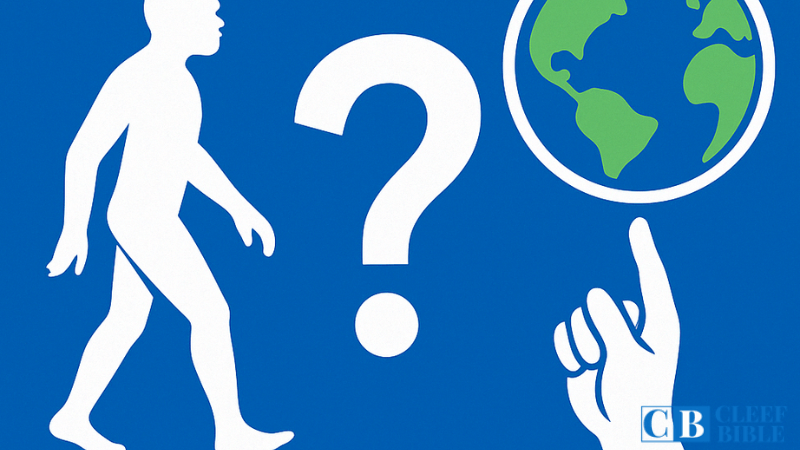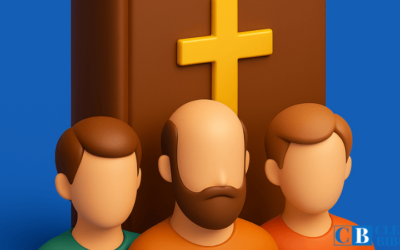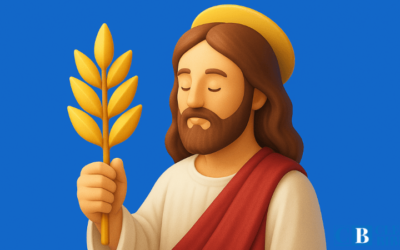Have you ever wondered how everything around us came to be?
Since time immemorial, humanity has tried to understand the origin of the universe and life on Earth.
Two of the most discussed and debated theories are evolution and creation or Evolution vs. Creation.
In this article, we'll explore both concepts, focusing specifically on the biblical account in Genesis 1:1-31 and how it compares to the theory of evolution.
Ready to dive into this fascinating debate?
Presentation of the Topic
The controversy between evolution and creation has been a hot topic for decades.
On the one hand, we have the biblical account of Genesis, which tells how God created the world in six days.
On the other hand, the theory of evolution, popularized by Charles Darwin in the 19th century, suggests that all species have evolved from common ancestors through a process of natural selection.
Both points of view have passionate advocates, and understanding their rationale is essential to forming an informed opinion.
Objective of the Article
The purpose of this article is to compare the theories of evolution and creation, providing a balanced, evidence-based perspective.
We will explore the historical and cultural context of each theory, describe the creation story in Genesis 1:1-31, and analyze the scientific and theological bases of both positions.
In the end, we hope to offer you a clearer and deeper insight into this fascinating debate.
Historical and Cultural Context

To better understand the context of Genesis in the Bible and the history of evolutionary theory, it is essential to explore the details of these topics.
Here I explain in detail some of the most important aspects:
The Context of Genesis in the Bible
The book of Genesis is the first book of the Bible and is fundamental to the Judeo-Christian religions.
Traditionally, its authorship is attributed to Moses, although its final writing may have been influenced by various sources and traditions.
Genesis was written in a cultural and religious context where creation myths were common.
However, the Genesis narrative is distinguished by its monotheism, presenting a single God as creator of all.
Here I explain how this context develops:
1. Authorship and writing of Genesis
Although Moses is traditionally considered the author of Genesis, scholars suggest that the text may have been influenced by multiple sources and traditions over time.
These sources include documents and oral narratives that were compiled and unified into the text we know today.
This diversity of sources reflects the rich history and theological depth of the biblical story.
2. Cultural and religious context
At the time Genesis was written, many ancient cultures had their own creation myths that explained the origin of the world and humanity.
These myths often involved multiple gods and complex narratives of chaos and order.
The Genesis account is notable for its focus on a single sovereign God who creates the universe with intentionality and purpose, contrasting with contemporary polytheistic myths.
3. Monotheism in Genesis
The Genesis narrative introduces the concept of monotheism, the belief in one almighty creator God.
This God is presented not only as creator, but also as maintainer and sustainer of all creation.
This monotheistic approach establishes a unique theological foundation that has profoundly influenced the Judeo-Christian religions.
History of the Theory of Evolution
The theory of evolution has its roots in Charles Darwin's observations during his voyage on the HMS Beagle.
In 1859, Darwin published “The Origin of Species,” where he set out his theory of natural selection.
This work revolutionized biology and changed our understanding of the development of life on Earth.
Despite initial controversy, the theory of evolution has been widely accepted by the scientific community due to the abundant fossil and genetic evidence that supports it.
Here I explain how this story develops:
1. Darwin's Observations
During his voyage aboard HMS Beagle, Charles Darwin made detailed observations of various life forms and their adaptations to their environment.
These observations, especially those of the Galapagos Islands, led him to formulate ideas about species variation and adaptation.
Darwin noted that species were not fixed, but could change over time in response to their environment.
2. Publication of “The Origin of Species”
In 1859, Darwin published his seminal work, “The Origin of Species,” in which he proposed the theory of natural selection as the primary mechanism of evolution.
Natural selection suggests that individuals with favorable characteristics are more likely to survive and reproduce, passing those characteristics on to the next generation.
This theory provided a naturalistic explanation for the diversity of life and radically changed biology.
3. Evidence and acceptance of the theory
Despite initial controversy, the theory of evolution has been supported by a wealth of evidence from diverse scientific disciplines, including paleontology, genetics, and molecular biology.
The fossil record shows a progression of life forms from the simplest to the most complex.
Modern genetics has confirmed and expanded our understanding of evolution, showing how genes and mutations play a role in the adaptation and diversification of species.
By expanding on these points, we can appreciate the depth and richness of the biblical account of Genesis and the scientific theory of evolution, seeing how both offer valuable insights into the origin and development of life on Earth.
Description of Creation in Genesis 1:1-31

To better understand the creation story according to the Book of Genesis in the Bible, it is essential to explore each day of creation and its theological significance.
Here I explain in detail some of the most important aspects:
Day 1: Creation of Light
“And God said, Let there be light; and there was light.”
This first act of creation establishes the distinction between light and darkness.
Theologically, light symbolizes the presence of God and his power to order chaos.
Here I explain how this process develops:
1. Distinction between light and darkness
God introduces light into the primordial chaos, separating it from the darkness and establishing order in the universe.
This separation is fundamental to creation, as it establishes the cycle of day and night.
Light represents good, clarity and life, while darkness symbolizes chaos and uncertainty.
2. Symbol of the presence of God
Light is seen as a reflection of God's presence and power, illuminating and guiding creation.
This act demonstrates that God is the source of all light and life, and that his presence brings order and purpose.
The introduction of light can also be interpreted as the beginning of divine revelation to the world.
Day 2: Creation of the Firmament

God separates the waters and creates the firmament, establishing heaven.
This day represents the organization of the cosmos and the creation of a habitable space for life.
Here I explain how this process develops:
1. Separation of the waters
God creates a firmament that divides the upper waters (sky) from the lower waters (seas and oceans).
This separation establishes an orderly structure in the universe, differentiating heaven from earth.
The firmament acts as a barrier that holds back the waters above, creating a space for the atmosphere and life.
2. Creating a living space
The establishment of the firmament and the organization of the cosmos prepare the ground for life.
This act shows God's intention to create a suitable and safe environment for living beings.
The sky, as part of the firmament, is also seen as a manifestation of the glory and greatness of God.
Day 3: Separation of Land and Sea and Creation of Vegetation

God gathers the waters, allowing dry land to appear, and creates vegetation.
This action not only sets the stage for animal life, but also underscores the ecological importance of plants as the foundation of the food chain.
Here I explain how this process develops:
1. Appearance of dry land
God commands the waters to gather in one place, allowing dry land to appear.
This act establishes the continents and oceans, creating a diverse environment suitable for terrestrial life.
The formation of land and sea is essential for the biodiversity and habitability of the planet.
2. Creation of vegetation
God commands the earth to produce plants, trees and all kinds of vegetation.
Vegetation is the first life form created, providing oxygen and food for future living beings.
Plants and trees play a crucial role in ecosystems, being the basis of the food chain and supporting animal life.
Day 4: Creation of the Stars

On the fourth day, God creates the sun, moon, and stars to mark the times and seasons.
This narrative contrasts with ancient cosmologies that worshipped the stars as deities.
Here I explain how this process develops:
1. Creation of the sun, moon and stars
God places lights in the firmament to illuminate the earth and separate day from night.
The sun is created to rule the day, while the moon and stars rule the night.
These stars also serve as signs for the times, seasons and years, providing a natural calendar.
2. Contrast with the worship of the stars
In many ancient cultures, the stars were worshipped as powerful gods.
The biblical story, however, presents the stars as creations of a single supreme God, demystifying his divinity.
This approach reinforces the idea of monotheism and God's sovereignty over all creation.
Day 5: Creation of Marine Animals and Birds

God fills the seas and skies with life, creating fish and birds.
This day reflects the biodiversity and abundance of life in different environments.
Here I explain how this process develops:
1. Creation of marine life
God commands the waters to produce living beings, including fish and other sea creatures.
The diversity of marine life shows God's creativity and power in filling the oceans with life.
Each marine species plays a vital role in the ecosystem, contributing to the balance of the oceans.
2. Creation of birds
God creates birds to fly over the earth and fill the skies.
Birds, with their different shapes, colors and abilities, add beauty and diversity to the world.
Its existence reflects God's ability to create life adapted to different environments, such as air and land.
Day 6: Creation of Land Animals and Man

God creates land animals and finally human beings in his image and likeness.
This culmination of creation highlights the importance and special purpose of human beings in the biblical narrative.
Here I explain how this process develops:
1. Creation of land animals
God commands the earth to produce living beings according to their kinds, including mammals, reptiles, and insects.
Each species is adapted to its environment and plays a crucial role in the terrestrial ecosystem.
The diversity of land animals shows the richness and complexity of God's design.
2. Creation of the human being
God creates human beings in his image and likeness, endowing them with unique capacities such as reason, creativity, and morality.
Humans are charged with governing and caring for the Earth, reflecting the divine responsibility and purpose in its creation.
Being created in God's image implies a special relationship with Him and a significant role in creation.
Day 7: God's Rest

On the seventh day, God rests and sanctifies this day.
This final act underlines the importance of rest and worship in human life.
Here I explain how this process develops:
1. God's Rest
After completing creation, God rests on the seventh day, establishing a pattern for work and rest.
This rest does not imply inactivity, but rather a pause to contemplate and enjoy the work completed.
God's rest sanctifies the seventh day, making it special and sacred.
2. Importance of rest and worship
The seventh day, known as the Sabbath, becomes a day of rest and reflection for humanity.
This day is an opportunity to disconnect from daily activities and reconnect with God and creation.
Sabbath observance underscores the need for balance in life, integrating work, rest, and worship.
Expanding on these points, we can appreciate the depth and planning in the biblical creation account, seeing how each divine act not only organizes the physical world but also sets the stage for an orderly and connected life.
Comparison of Theories

To better understand the scientific basis of the theory of evolution and the theological basis of biblical creation, it is essential to explore the details of these concepts.
Here I explain in detail some of the most important aspects:
Scientific Basis of the Theory of Evolution
Evolution is based on natural selection and genetic mutation.
Fossil evidence shows a gradual progression from simple to complex life forms.
Furthermore, genetic studies have confirmed the relationship between different species, supporting the idea of common ancestors.
Here I explain how this process develops:
1. Natural selection and genetic mutation
Natural selection, proposed by Charles Darwin, is the process by which characteristics favorable for survival are transmitted to the next generation.
Genetic mutations, which are changes in DNA, provide the variability on which natural selection acts.
These mutations can be beneficial, neutral, or harmful, and those that improve an organism's adaptation to its environment tend to be preserved.
2. Fossil evidence
Fossils are remains or impressions of ancient organisms preserved in rocks.
The fossil record shows a sequence of gradual changes in life forms, from simple to complex organisms.
Examples such as transitional fossils illustrate how certain groups of organisms have evolved over time.
3. Genetic studies and relationships between species
Modern genetics has provided strong evidence of the relationship between different species.
DNA analysis shows similarities and differences that reflect evolutionary history and common ancestry.
For example, humans share a high percentage of their DNA with chimpanzees, indicating a recent common ancestor.
Theological Basis of Biblical Creation
The Genesis story can be interpreted literally or allegorically.
Literal creation proponents view the six days of creation as 24-hour days, while others interpret these days as symbolic periods of time.
Divine creation rests on faith and the interpretation of Scripture.
Here I explain how this process develops:
1. Literal interpretation
The literal interpretation of Genesis holds that God created the world in six 24-hour days.
Each day of creation corresponds to a specific action of God, creating light, sky, earth, plants, stars, animals and finally, human beings.
This view emphasizes God's omnipotence and ability to create instantly and completely.
2. Allegorical or symbolic interpretation
Some theologians interpret the days of creation as longer periods of time, not necessarily 24 hours.
This interpretation allows for greater compatibility with scientific discoveries about the age of the Earth and the gradual development of life.
Creation is seen as a process directed by God, who uses natural means to carry out his plan.
3. Faith and the Scriptures
Belief in divine creation is based on faith in the authority of Scripture and God's revelation.
The Genesis account not only describes the origin of the world, but also conveys theological truths about the nature of God and his relationship to creation.
Faith in creation emphasizes the divine intention and purpose behind the existence of the universe.
By expanding on these points, we can appreciate the depth of both the scientific foundations of the theory of evolution and the theological foundations of biblical creation, seeing how each approach offers a distinct perspective on the origin and development of life on Earth.
Final Reflection
Importance of Debate for Today's Society
This debate is not just academic; it influences our culture, education, and politics.
Addressing these issues with an open mind and respect is crucial for a harmonious society.
Conclusion
The debate between evolution and creation is one of humanity's oldest and most fascinating.
It invites us to reflect on our origin, our existence and the purpose of life.
Both the theory of evolution and the biblical account of creation offer us unique and valuable insights.
Science provides us with tools to understand the how of our existence, while faith helps us find the why.
In a constantly changing world, it is crucial to maintain an open mind and encourage dialogue between different points of view.
By exploring these theories, we not only expand our knowledge, but also enrich our understanding of the universe and ourselves.
What do you think about this debate between evolution and creation?
How has it influenced your perspective or your faith?
Leave your comment and share your experience with us.
We want to hear your opinion!
Discover How the Bible Can Transform Your Life
- Bible Study – explore the teachings of the Bible and find answers to life’s challenges.
- Fundamental Beliefs – delves into the principles that have guided millions through the centuries.
- Spiritual Growth – Strengthen your faith with studies designed to bring you closer to God.

Discover How the Bible Can Transform Your Life
- Bible Study – explore the teachings of the Bible and find answers to life’s challenges.
- Fundamental Beliefs – delves into the principles that have guided millions through the centuries.
- Spiritual Growth – Strengthen your faith with studies designed to bring you closer to God.

Frequently Asked Questions about Evolution vs. Creation in Genesis 1:1-31
What is the main difference between evolution and creation?
Evolution is based on natural processes of gradual change, while creation involves direct divine intervention.
Can science and religion coexist?
Many believe so, arguing that science explains the “how” and religion the “why.”
What is intelligent design?
It is the theory that suggests that certain features of life are best explained by an intelligent cause rather than a natural process.
Why is this debate important?
It affects our understanding of the world, our beliefs and education.
What evidence supports the theory of evolution?
Fossil evidence, genetic studies, and observations of evolutionary changes in species.
What interpretations exist of Genesis?
Literal, symbolic and allegorical, each with its own theological focus.
How is this debate taught in schools?
It varies by country and educational system, some teach both points of view, others focus on evolution.
What impact does this debate have on faith?
It can strengthen the faith of some and challenge that of others, depending on their perspective.
Is the theory of evolution just a theory?
In science, a theory is a well-founded, evidence-based explanation, not a mere assumption.
How can we reconcile science and religion?
Through dialogue and mutual respect, seeking common ground and understanding differences.
What do you think about the debate between evolution and creation?
Leave us your comment and share your point of view!


























0 Comments